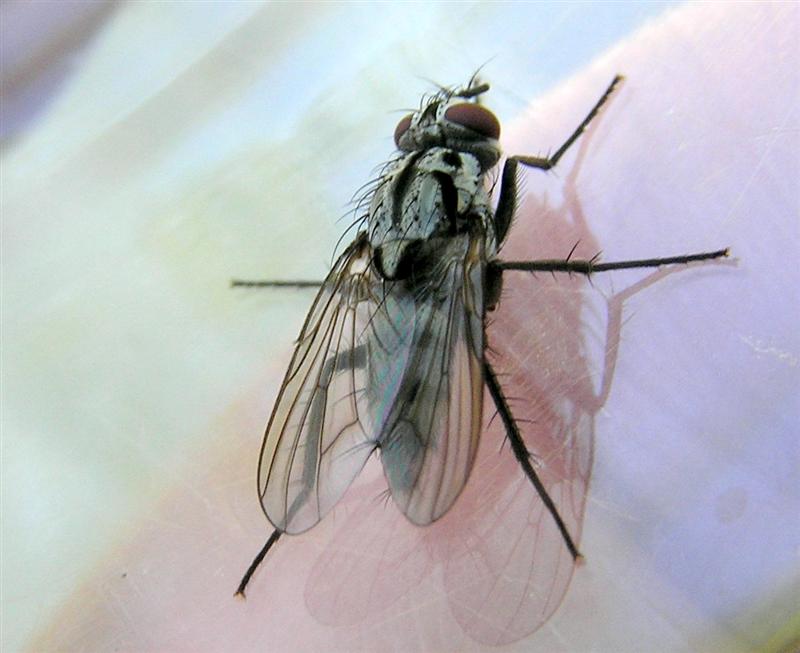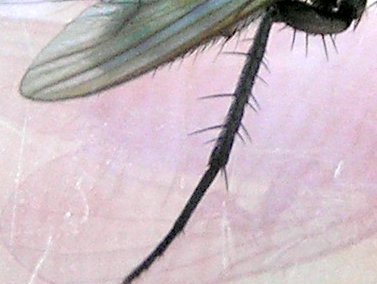Diptera.info :: Identification queries :: Diptera (adults)
|
Anthomyia
|
|
| Gordon Jar |
Posted on 18-07-2006 12:08
|
|
Member Location: East Sussex, England Posts: 209 Joined: 09.10.05 |
The attached was photographed on 11/07/06 in South East England. Initially I thought it was Anthomyia pluvialis but when viewing the photo I saw that the markings did not match any photos I have of A.pluvialis. Is this A. procellaris ? Many thanks Regards Gordon Gordon Jar attached the following image:  [54Kb] |
|
|
|
| Nikita Vikhrev |
Posted on 18-07-2006 12:23
|
|
Member Location: Moscow, Russia Posts: 9500 Joined: 24.05.05 |
Hi Gordon. As far as I know it does matter 2 or 3 black spots on thorax before sutur and shape of black spot(s) on scutellum. In your case 3 spot and scutellum color - all it have to be with A. pluvialis. Nikita Nikita Vikhrev - Zool Museum of Moscow University |
|
|
|
| Robert Nash |
Posted on 18-07-2006 13:09
|
|
Member Location: Ulster Museum, Belfast, Ireland Posts: 288 Joined: 11.11.05 |
We'll have to take a look at a monograph and what keys we can find after gathering all the cf. pluvialis posts together.It's an exciting but daunting prospect Fauna Europea lists 15 species for the genus Robert PS. Easier for England if the checklist is correct. |
| Kahis |
Posted on 18-07-2006 13:39
|
|
Member Location: Helsinki, Finland Posts: 1999 Joined: 02.09.04 |
Do nto worry, it is not a Antomyia at all, but a Eustalomyia (also Anthomyiidae). Two species are possible, E. festiva or E. histrio. I have only a male of the former in my collection; it is a very good match.
Kahis |
| Robert Nash |
Posted on 18-07-2006 14:12
|
|
Member Location: Ulster Museum, Belfast, Ireland Posts: 288 Joined: 11.11.05 |
Not my day at all. First the Bellardia catastophe. Now this. Perhaps it's the heat 30. Robert |
| Nikita Vikhrev |
Posted on 18-07-2006 15:00
|
|
Member Location: Moscow, Russia Posts: 9500 Joined: 24.05.05 |
It is not my day too . And weather is rather cool in Moscow. . And weather is rather cool in Moscow.On the other hand, day is good. Yesterday I red about Eustalomyia keying Hylemya. Now, grace to Gordon and Kahis, I've seen Eustalomyia too. Nikita Nikita Vikhrev - Zool Museum of Moscow University |
|
|
|
| Gordon Jar |
Posted on 18-07-2006 16:52
|
|
Member Location: East Sussex, England Posts: 209 Joined: 09.10.05 |
Thankyou very much Regards Gordon |
|
|
|
| Tony Irwin |
Posted on 19-07-2006 01:05
|
|
Member Location: Norwich, England Posts: 7320 Joined: 19.11.04 |
Hi Gordon Kahis is right - it's either Eustalomyia festiva or histrio. If you still have the specimen, they're easy to tell apart. In festiva, the aristal hairs are as long as the third antennal segment (first flagellomere) is wide - i.e. short-plumose. In histrio the hairs are very short - i.e. pubescent. Also the hind tibia has 7 av setae in festiva and 12 in histrio. - Easy!  Incidentally I caught two histrio resting on tree-trunks near Norwich a couple of weeks ago. Both festiva and histrio are fairly common in the South of England. (Information on identification and distribution from Mike Ackland's excellent CD of British anthomyid keys and drawings). Tony ---------- Tony Irwin |
|
|
|
| Gordon Jar |
Posted on 19-07-2006 20:38
|
|
Member Location: East Sussex, England Posts: 209 Joined: 09.10.05 |
Thanks for that Tony. I don't collect specimens as I don't have the facilities to examine them.  Or the expertise  but I am seeking to improve in that area. but I am seeking to improve in that area.I have been looking to find reference to Av setae but am at a loss to find an explanation to Av. Could you perhaps give me a hint of what Av setae means. I have attached a close up of the hind tibia. Regards Gordon Gordon Jar attached the following image:  [23.06Kb] |
|
|
|
| Nikita Vikhrev |
Posted on 19-07-2006 20:47
|
|
Member Location: Moscow, Russia Posts: 9500 Joined: 24.05.05 |
Hi Gordon. As at the map there are South - North and West - East, same on the fly's leg in natural position are Ventral - Dorsal and Antero (=forward) - Postero (= back = hind). So, I go S-W = I go south-west and Seta AV = seta 45 dergee from both forward and ventral position. Nikita Nikita Vikhrev - Zool Museum of Moscow University |
|
|
|
| Tony Irwin |
Posted on 19-07-2006 23:07
|
|
Member Location: Norwich, England Posts: 7320 Joined: 19.11.04 |
Hi Gordon Your follow-up photo shows 7 (+ 1 small) antero-ventral bristles, so I think we can go with festiva. Tony ---------- Tony Irwin |
|
|
|
| Gordon Jar |
Posted on 20-07-2006 10:52
|
|
Member Location: East Sussex, England Posts: 209 Joined: 09.10.05 |
Thankyou all for your patience, It's so much easier for me when I you know what people are talking about. Now I know that 7 can = 8.  Regards Gordon Edited by Gordon Jar on 20-07-2006 10:53 |
|
|
|
| Paul Beuk |
Posted on 20-07-2006 12:05
|
|
Super Administrator Location: Netherlands Posts: 19403 Joined: 11.05.04 |
LoL: try antenroventral![header=[antenroventral] body=[The Glossary contains no matching items.<br />It may have been added using different lettering,<br />so you can click the Term to check this.<br />Otherwise, contact the Administrator to report this error.<br /><img src='../infusions//terms/images/no_image.gif' style='vertical-align:middle;' />] delay=[0] fade=[on]](../infusions/terms/images/help.gif) , Av , Av![header=[Av] body=[The Glossary contains more than one matching items.<br />Click the Term to see the options.<br /><img src='../infusions//terms/images/no_image.gif' style='vertical-align:middle;' />] delay=[0] fade=[on]](../infusions/terms/images/help.gif) or av or av![header=[av] body=[The Glossary contains more than one matching items.<br />Click the Term to see the options.<br /><img src='../infusions//terms/images/no_image.gif' style='vertical-align:middle;' />] delay=[0] fade=[on]](../infusions/terms/images/help.gif) (all will lead you to the same page, though). (all will lead you to the same page, though).
Paul - - - - Paul Beuk on https://diptera.info |
| Robert Nash |
Posted on 20-07-2006 12:15
|
|
Member Location: Ulster Museum, Belfast, Ireland Posts: 288 Joined: 11.11.05 |
Also leg setae (under L in the Glossary ) noting the flexion plane. ) noting the flexion plane. Anteroventral (more generally) is also explained in the glossary as Paul says. It is not linking because of a typo which is probably a result of the hot weather. Cheers Robert Edited by Robert Nash on 20-07-2006 14:06 |
| Jump to Forum: |













